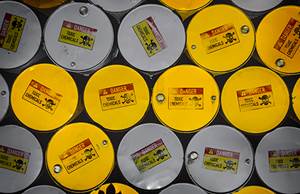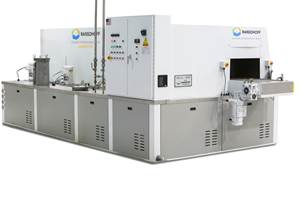Taking Care of an Industrial Parts Washer
Proper parts washer maintenance is key to a long life for the system and reliable parts washing.

Pssst. Hey, it’s me, your parts washer. Can we talk for a minute?
You ask me to do a lot for your manufacturing process, but there are a few things you can do for me in return that will help me give you the best cleaning process possible. In the words of Rodney Dangerfield, “I don’t get no respect.” It’s time we have a chat and fix that. By paying attention to a few simple matters, you can ensure I will give you years of effective and sustainable cleaning. For starters, feed me with good quality water. Water that is too hard makes my plumbing clog up over time. A good water treatment system for charge and makeup water will extend the life of my plumbing from the tank all the way out to my spray nozzles. My wash bath heaters will thank you, too.
A good relationship is often about chemistry. If you do not have a chemistry program in place, get one. It can help with the proper chemistry for the water you have, the part materials you are cleaning and the contaminants you are washing off. A good dosing system helps a lot to put the proper amount of chemistry in when you add water to my bath. I also highly recommend that you check (titrate) the wash bath chemistry levels on a frequent basis to ensure consistency in your cleaning process.
Let’s keep it clean. Depending on the type of fluid contaminants — such as oils and coolants — that you’re asking me to clean off your parts, you will need to change my wash bath on a regular basis. Oils will float and can be separated and removed from my bath. But some coolants or other fluids are water-soluble and mix into the wash bath. Many of these fluids have a form of sugars in them, and bacteria love sugars. Couple that with a hot, steamy environment in my tank and you can see why I start to stink after a bit. Biocides help for a while, but changing my bath water is the best way to eliminate these odors.
Perform a thorough clean-out of my tanks once a year to remove all the soap scum and debris, too.
Listen to my needs. I’m not high maintenance, really. Just pay attention to a few items. First, please change my water filters and air filters regularly. Check the chip basket now and then. Check my nozzles for flow, pressure and direction. Check my pumps for flow and performance. Check my wash bath heaters and replace them if they have buildup on the elements.
Clean out my blow-off area – especially the piping, hoses, nozzles and manifolds. I just washed parts for you, and you may be blowing dirty air back on them to dry.
Check my sensors, switches, e-stops and safety equipment to make sure they are working properly, not only for my safety but that of your operators, too.
Follow all the daily, weekly, monthly and annual maintenance items in my owner’s manual.
Share the responsibility. While we are talking about machine maintenance, how about my fellow machines in the production process? Give me a fighting chance to clean your parts by paying attention to those machines and process operations upstream of me. I can only do so much to clean a part and remove chips or other contaminants. I cannot fix problems caused by another machine, tooling or process failures.
How about some upgrades? Maybe I could use an oil separator, more filtration, magnetic separator or mist collector to perform better. Put on some flow meters and pressure sensors to monitor my performance.
There are processes after the cleaning that can affect the final cleanliness. Pay close attention to how parts are handled once they leave your washer and to the environment outside of the washer. I cannot keep them clean once they leave me.
Know your needs. Last, know your cleanliness specifications. Take some time to learn what they really mean in relation to your parts and the cleaning process. Understand metallic weight and particle size of residual contamination and what you can do to affect the outcome. Some materials, such as cast iron, naturally shed material no matter how much you clean. How about fibers versus metallic? Where are the fibers coming from? Are the parts oriented correctly? Is there adequate time under spray? I need the right time, heat, impingement and chemistry to get the job done.
Questions? Contact your parts washer manufacturer or service provider.
Good talk.
About the Author
Don Reeder
Don Reeder is general manager, Sugino Corp. Contact: suginocorp.com
Related Content
Environmentally Friendly Model 550 Versatile Parts Washer
PMTS 2023: This washer is useful in a variety of applications, including tool rooms, maintenance operations, low production and precision cleaning.
Read MoreOvercoming 3 Common Challenges With Automated Particle Counting
Facing difficulties while performing particle analysis is normal but should not be discouraging. Here are some ways to handle the most prevalent issues that can arise.
Read MoreParts Cleaning Sector Shifts Energy Toward Regulatory Changes
With changes in EPA regulations regarding the use of some popular cleaning fluids, cleaning suppliers and end users are readjusting business strategies and/or cleaning processes to meet new requirements.
Read MorePMTS 2023 Product Preview: Parts Cleaning
Learn about some of the latest parts cleaning solutions that will be on display at PMTS 2023.
Read MoreRead Next
The Basics of Cleaning with a Parts Washer
Better Engineering answers the question of “What do I need to know about an aqueous parts washer and its process?”
Read MoreVideo: The Advantages of CNC in a Cleaning/Deburring Process
This on-demand webinar from Sugino Corp. offers information on CNC waterjet for cleaning and deburring parts, pressure pumps and nozzle options for the system as well as how to add value to the process.
Read MoreAutomated Cleaning System Improves Productivity
This rotary basket washer drastically reduced the number of operators tending to the cleaning process as well as removed the bottleneck from that station.
Read More






















